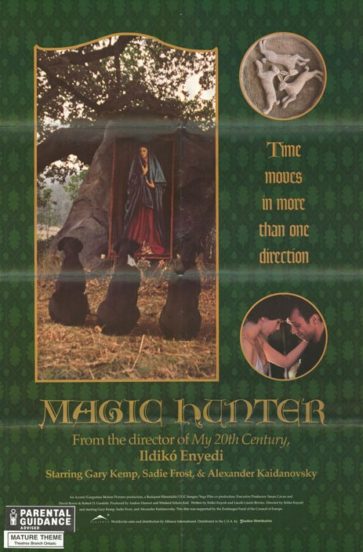 Certainly the only movie you’ll find that features suicidal sharpshooters, magic bullets, living paintings, time tripping rabbits, the Virgin Mary and the Devil, THE MAGIC HUNTER may not be perfect, but it is required viewing for cult movie buffs.
Certainly the only movie you’ll find that features suicidal sharpshooters, magic bullets, living paintings, time tripping rabbits, the Virgin Mary and the Devil, THE MAGIC HUNTER may not be perfect, but it is required viewing for cult movie buffs.
This 1994 effort was the second film by Hungary’s Ildiko Enyedi, following 1990’s well-received MY TWENTIETH CENTURY. THE MAGIC HUNTER (BUVOS VADASZ) wasn’t nearly as celebrated as MY TWENTIETH CENTURY, although it did receive a brief U.S. release courtesy of presenter David Bowie(!). That release, FYI, was in Hungarian with English subtitles, a big improvement over the dreadful English dubbing that accompanied the film’s North American film festival screenings.
In the horror and chaos of WWII a mother tells her daughter a story about the devil. According to the story, “Whoever sells his soul to the devil gets seven bullets in return,” each of which is guaranteed to hit its target. Cut to modern-day Budapest, where police sharpshooter Max accidentally shoots a woman he was supposed to protect. Cut to a small village in the middle ages, where the Devil, in the form of a wily longhair with tiny horns sprouting from his head, is afoot. The latter builds a small bridge over a stream, claiming that anyone who crosses it will be under his dominion—until one day a snail makes its way across the bridge, nullifying the Devil’s power.
Back in the present a despairing Max tries to shoot himself in the head and, unbelievably enough, misses. His young daughter, meanwhile, appears to have some connection to other time periods, as does a shady man who gives Max several bullets—and is recognizable as the Devil from the middle-ages set sequences. The latter hasn’t changed his ways, cajoling Max’s daughter into stealing the bullets.
Back in the middle ages a rabbit is chased by dogs, and finds refuge in a painting of the Virgin Mary that periodically comes to life. Said painting is on display in a modern museum when it suddenly comes to life again, releasing the Virgin Mary and the rabbit into the here-and-now, and just in time for a violent incident involving Max and one of the magic bullets.
Directorially this film can only be classified as a wildly mixed bag, with moments of brilliance juxtaposed with a lot of clumsiness and amateurism. The transitions between centuries (a dash through a dark tunnel turning into an X-ray view of blood rushing through veins, a teardrop that becomes a rainstorm) are bold and impressive, as is the magisterial use of music.
Unfortunately Ildiko Enyedi evinces little skill in directing actors, with Gary Kemp sleepwalking his way through the lead role and the domestic scenes between he and Sadie Frost (a real-life couple at the time) falling hopelessly flat. The strongest sequences are those set in the middle ages, which are convincingly depicted and have an energy the rest of the film lacks.
At least the modern day-set ending is good, bringing together several of the elements of the preceding segments in a most imaginative and enchanting manner.
Vital Statistics
THE MAGIC HUNTER (BUVOS VADASZ)
Budapest Filmstudio
Director: Ildiko Enyedi
Producers: Andras Hamori, Wieland Schulz-Keil
Screenplay: Ildiko Enyedi, Laszlo Laszlo Revesz
Cinematography: Tibor Mathe
Editing: Maria Rigo
Cast: Gary Kemp, Sadie Frost, Alexander Kaidanovsky, Peter Vallai, Mathias Gnadinger, Alexandra Wasscher, Ildiko Toth, Natalie Conde, Zoltan Gera, Philippe Dudos
